You are using an out of date browser. It may not display this or other websites correctly.
You should upgrade or use an alternative browser.
You should upgrade or use an alternative browser.
If Twitter is done, so is our access to immediate information EDIT: It's Over
- Thread starter EARFQUAKE
- Start date
More options
Who Replied?
Alexander Hay (@alexanderhay@mastodon.social)
Something happening on the #Russian Invasion of #Ukraine Live Threads over on #Reddit - users are rapidly embracing #Mastodon links, and there is a demand for it as a viable #Twitter alternative. Given how much these mega-threads have relied on the Bird Site for updates over the last 17 months...
AStrangeName
Member of Snitch Syndication
someone in the comments said "yall giving Jehovah witnesses a run for they money"


They be doing the same thing with Hive Social

Rod Hilton (@rodhilton@mastodon.social)
Oh wow so apparently Tweet threads are now limited to 25 messages per thread. I assume this is to drive more signups to Twitter Blue, where the character limit has been increased per-tweet. The way this guy is shaking down every possible revenue angle like he's broke and the rent is due at the...




Twitter Death Cult (@cspam@mastodon.cloud)
Attached: 1 image Is that a fact? https://www.reuters.com/world/europe/twitter-not-suited-emergency-communications-dutch-say-after-storm-2023-07-05/ "Twitter is not the right place to seek information during an emergency, Dutch politicians and a prominent online group said on Wednesday...
/cloudfront-us-east-2.images.arcpublishing.com/reuters/ENWJP3QCWRPY3BJDD5EAO6J4JE.jpg)
Twitter not suited for emergency communications, Dutch say after storm
Twitter is not the right place to seek information during an emergency, Dutch politicians and a prominent online group said on Wednesday, following an incident in which citizens were directed to the platform for updates during a large storm.

Threads isn’t for news and politics, says Instagram’s boss
Adam Mosseri says it isn’t going to “encourage” these verticals.
Threads isn’t for news and politics, says Instagram’s boss
/
Adam Mosseri ran Facebook’s News Feed in 2016, and now he tells Alex Heath that politics and hard news aren’t ‘worth the scrutiny, negativity (let’s be honest), or integrity risks.’
By Jay Peters, a news editor who writes about technology, video games, and virtual worlds. He’s submitted several accepted emoji proposals to the Unicode Consortium.Jul 7, 2023, 2:16 PM EDT
:format(webp)/cdn.vox-cdn.com/uploads/chorus_asset/file/24774110/STK156_Instagram_threads_1.jpg)
Illustration: The Verge
Instagram’s new Threads app is “not going to do anything to encourage” politics and “hard news,” Instagram boss Adam Mosseri said in a Threads conversation with The Verge’s Alex Heath.
The additional scrutiny, negativity, and integrity risks that come with politics and hard news aren’t worth the “incremental engagement or revenue,” Mosseri wrote.
“There are more than enough amazing communities — sports, music, fashion, beauty, entertainment, etc. — to make a vibrant platform without needing to get into politics or hard news.” (Mosseri’s strong point of view here is likely informed by his time running Facebook’s News Feed.)
In recent years, Meta has distanced itself from news and politics, including reducing the amount of political content that users see on Facebook. It even dropped “News” from the name of the Facebook Feed last year. The company also responded to a new Canadian law that would require it to pay for local news by saying it will yank news from Facebook and Instagram in the country.
While Threads is assuredly a take on Twitter, a platform tying itself in knots under new ownership, Mosseri is apparently thinking much bigger. Following along with his boss, Mark Zuckerberg's statement about finding a “clear path to 1 billion people,” Mosseri said:
The goal isn’t to replace Twitter. The goal is to create a public square for communities on Instagram that never really embraced Twitter and for communities on Twitter (and other platforms) that are interested in a less angry place for conversations, but not all of Twitter.
Threads launched on Wednesday and has proven to be a big hit; it’s already surpassed 70 million signups. But the vibe, so far, is decidedly not like what you might be familiar with from Twitter: the only available feed is an algorithmic one, and that feed is already flooded with celebrities and brands.

Still, it seems inevitable that politics and news will trickle onto Threads in some way, especially if politicians and journalists use the platform during the 2024 presidential election cycle. And Instagram is working on a feed just for people you follow and a chronological feed, which, at least for me, should make Threads a much more useful place to find news. But it sounds like Instagram won’t be going out of its way to make Threads what Twitter once was — so don’t get your hopes up for some kind of Thread-Deck.

Japan Earthquake Alert App Says Sayonara to X - Unseen Japan - technology - kbin.social
Many people in Japan depend on the NERV service for earthquake alerts. Unfortunately, they'll no longer be able to receive them on X.

Japan Earthquake Alert App Says Sayonara to X - Unseen Japan
Many people in Japan depend on the NERV service for earthquake alerts. Unfortunately, they'll no longer be able to receive them on X.
Japan Earthquake Alert App Says Sayonara to X
Japan Earthquake Alert App Says Sayonara to X

Picture: Canva
- August 11, 2023
- Tags: natural disasters, nerv, twitter
- Category: Technology
Himari Semans
Many people in Japan depend on the NERV service for earthquake alerts. Unfortunately, they'll no longer be able to receive them on X. Here's why the NERV app is parting ways with the platform.
Japan’s best safety app for natural disasters will withdraw from X (formerly Twitter). 1.9M followers have relied on the app NERV for live information about real-time natural disasters and weather reports. Now, this life-saving information will begin its fadeout from the social media platform.
An important lifeline
The Japanese IT service management company Gehirn Web Services made the announcement on August 7th. The company said it will no longer post information regarding power outages and evacuation measures on its official account on X, citing harsh API constraints.
Gehirn owns and manages the NERV Disaster Prevention App (called Tokumu-Kikan-NERV (特務機関NERV in Japanese). NERV swiftly distributes the company’s analysis of real-time earthquakes, tsunamis, typhoons, and weather information.
The app instantly gained recognition from the government’s Japan Meteorological Agency when Gehirn released it in 2019.
The speed of delivery is what distinguishes NERV from other distributors. NERV is “10 seconds or more faster than breaking news on TV,” say experts. NERV retrieves data from real-time earthquakes, analyzes it, and posts information in just 0.3 seconds. The media has praised NERV, saying that “there is no app that delivers such information as quickly and accurately.”
Monday’s post on the official X account for NERV shared Gehirn’s plans to discontinue its use of X. The same post stated that the company will share future NERV content on its app and on Mastodon.
An expensive API

By 9 PM on Monday night, NERV users were demanding answers to the questions raised by Gehirn’s decision. NERV responded to two questions.
Why not use other social media platforms?
“We are moving forward under the premise that our operations should move from platforms managed by other companies to those within our control. Our app of course works on Apple and Google but these are different in terms of API constraints. On the other hand, distribution on ActivityPub is where we can manage our content completely independently. For this reason, in response to requests to move our operations onto different platforms will eventually only result in the same outcome as this time and therefore will not be considered. As NERV posts are still accessible via social media linked with ActivityPub, we plan to continue sharing there.”
What is the situation with X’s API plan?
Currently, we subscribe to the API’s “Basic plan”. With the Basic plan, we are granted 100 posts per 24 hours for the cost of $100 (under current rates this amounts to for the cost of $100 (under current rates this amounts to for the cost of $100 (under current rates this amounts to ¥14,236). The plan above this is the “Pro plan” which costs $5,000 (¥711,715) per month. Our operations run with a budget spent on various studies and development projects.
This month, we find ourselves in the red by n the red by ¥6,000,000 which can hardly qualify as a good financial situation as we continue with our operations. If we upgrade to the Pro plan, we will incur a cost of over ¥8,540,000 per year. We have decided that if we were to spend over ¥700,000 per month that it would be better if this money could go to developing our NERV app and strengthening our ActivityPub servers instead of X’s API. Therefore, we are beginning to cut down on our posts on X.
Repercussions for other Japanese services
NERV’s issues with X’s API constraints began earlier this month on August 1st when it announced that it was “unable to automatically publish posts due to API constraints.”
Gehirn is not alone in its recent concerns over X’s API constraints. The Japanese website Togetter which specializes in processing viral Tweets experienced glitches with X’s API too when X demoted its plan to the “Free plan.”
As for now, the NERV account on X is still posting real-time updates every few hours on weather patterns as well as passing typhoons in Japan.
NERV’s origins
The name NERV comes from the Japanese anime Neon Genesis Evangelion, of which the app’s founder is a huge fan.
Ishimori Daiki created the first account for NERV in 2010 while he was still a student at Tsukuba University in Japan. NERV was a hobby to him. A hobby that had just 300 followers.
But then, the Tōhoku earthquake and tsunami happened in 2011. The home Ishimori had grown up in was destroyed. He lost his aunt. Ever since, Ishimori has poured all of his energy into improving the distribution of information for natural disasters.
When Ishimori’s company Gehirn released the NERV app in 2019, there were 10,000 downloads. Now, there are 206,000. Hopefully, its app continues to enjoy success – and serve its important purpose for users in Japan.
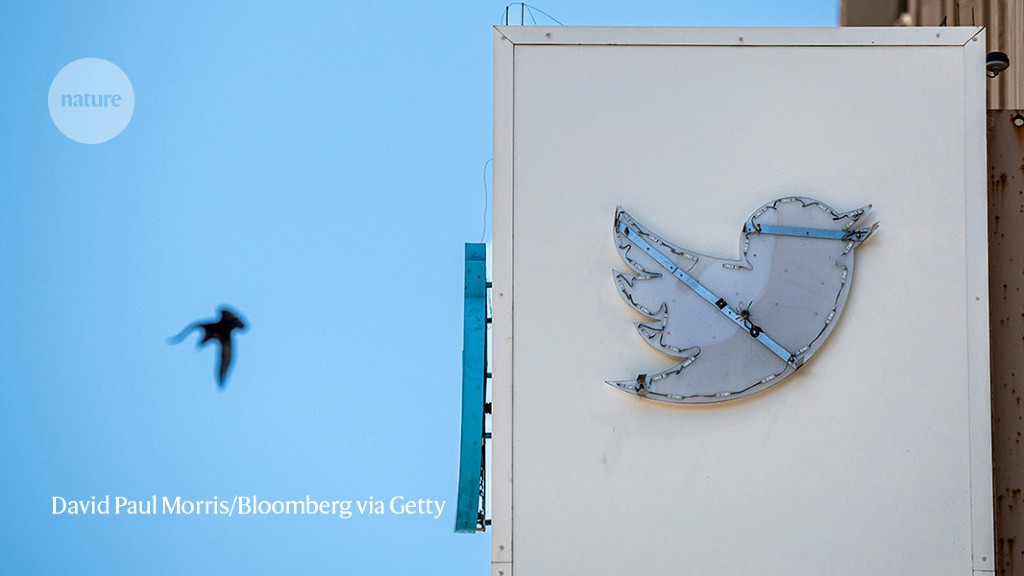
Thousands of scientists are cutting back on Twitter, seeding angst and uncertainty
A Nature survey reveals scientists’ reasons for leaving the social-media platform now known as X, and what they are doing to build and maintain a sense of community.
- NEWS FEATURE
- 16 August 2023
Thousands of scientists are cutting back on Twitter, seeding angst and uncertainty
A Nature survey reveals scientists’ reasons for leaving the social-media platform now known as X, and what they are doing to build and maintain a sense of community.
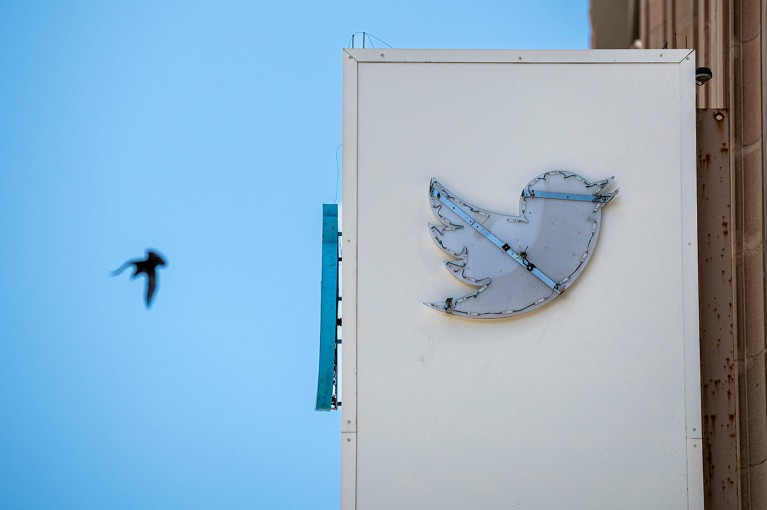
Hundreds of respondents to a Nature survey say they have left the platform formerly known as Twitter. Credit: David Paul Morris/Bloomberg via Getty
Emilia Jarochowska joined Twitter in 2016 in the hope that it might help to enhance her career. She was finishing her PhD in palaeontology at the time, and felt that the platform would help her to connect with colleagues and find job opportunities. But that was, she says, before the platform became a “sea of bad trolls”.
Last December, after much consideration and several experiences of fighting misinformation on climate change and COVID-19, Jarochowska closed her account, feeling that her reputation could be at risk if she kept using the platform. She felt that Twitter was promoting provocative discourse over facts and encouraging a type of controversy that “is not what scientists should be associated with”, she says.
A survey conducted by Nature suggests that Jarochowska, now at Utrecht University in the Netherlands, is far from alone in curtailing her use of the platform. Since entrepreneur Elon Musk took control in October 2022, he has made a series of largely unpopular changes to Twitter, including cutting down on content moderation; ditching its ‘blue-check’ verification system in favour of one that grants paying members additional clout and privileges; charging money for access to data for research; limiting the number of tweets users can see; and abruptly changing the platform’s name and familiar logo to simply ‘X’. His management has left scientists reconsidering the value of X, and many seem to be leaving.
To get a better sense of how researchers are currently interacting with the site formerly known as Twitter, Nature reached out to more than 170,000 scientists who were, or still are, users; nearly 9,200 responded. More than half reported that they have reduced the time they spend on the platform in the past six months and just under 7% have stopped using it altogether. Roughly 46% have joined other social-media platforms, such as Mastodon, Bluesky, Threads and TikTok.
With this migration has come widespread uncertainty. Many academics worry that the changing social-media landscape is undoing some of the advances that Twitter helped to facilitate in diversity, equity and inclusion for academia.
For example, Cristina Dorador, a microbial ecologist at the University of Antofagasta in Chile, says that Twitter helped her promote her research to her country and the world. Without a social-media platform that is as universal as Twitter, she worries that she and others won’t have a lot of options to make their work more visible, and many researchers don’t have the resources to keep up with the changes that X is making. “I don’t see a Latin American researcher paying to verify their account so people read what they’re publishing,” she says.
For now, it’s hard to predict what will become of X, but the changes are creating angst in the scientific community and challenging scientists and the academic establishment to redefine how they share science and build community. “If everybody disappears from Twitter, if it goes belly up or just becomes completely useless, I think that’s going to limit the reach of some of my work,” says Stuart Pearson, a coastal engineer at Delft University of Technology in the Netherlands. Although he has started to see people from his network leave or become less active, he’s not ready to let go himself, because it took him years to gather followers and build his network. “I can’t say I’m too eager to repeat that again.”
Why are they leaving?
Nature obtained the e-mail addresses of thousands of scientists who were identified through a social-media research project as having tweeted about papers on which they were a corresponding author1. The survey from Nature asked whether people had changed their use of Twitter in the past six months and why. The reasons respondents gave varied, but many of those who had markedly reduced or stopped their activity on X mentioned Musk’s management of the platform. Many said that they had noticed an uptick in the amount of fake accounts, trolls and hate speech on the platform.Žiga Malek, an environmental scientist at the Free University of Amsterdam, mentioned in the survey that he had started seeing a lot of “strange” political far-right accounts espousing science denialism and racism in his feed. He has to block them constantly. “Twitter has always been not so nice let’s say, but it is a mess right now,” he said.
Researchers have found that, contrary to such public claims from Musk, hate speech increased after he took over2. Musk has threatened to sue at least one group studying these trends.
A lot of experts and specialists are leaving the platform, says Timothy Caulfield, a law scholar and science communicator at the University of Alberta in Edmonton, Canada. “If that happens, are we just making room for a massive echo chamber that can spread misinformation in a way that is very harmful to society?”
X did not respond to Nature’s request for comments.
Where are they going?
The most popular alternative social-media site that respondents mentioned opening accounts with was the free, open-source software platform Mastodon. Compared with X, Mastodon allows for better community moderation, says Rodrigo Costas, an information scientist at the Centre for Science and Technology Studies at Leiden University in the Netherlands, who has been studying scientists’ use of Twitter since 2011. In February, he and Jonathan Dudek, a communications researcher also at the Centre for Science and Technology Studies, examined the Twitter profile information of 400,000 researchers — obtained for a previous research project3 — to see who was broadcasting their movement to other platforms. Roughly 3% of the profiles mention a Mastodon account, according to the researchers’ preliminary analysis.Although it has been around for some seven years, Mastodon has a much smaller user base than do other social-media platforms. In Nature’s survey, LinkedIn was the second most popular place for respondents to open new accounts, and Instagram, owned by Meta, was third. Threads, also owned by Meta and pitched as an alternative to X, had started just a few days before the survey was launched. It reportedly attracted 100 million users in its first five days, and was the fourth-most-popular platform among survey respondents, with about 1,000 people saying that they had joined (See ‘Signs of dissatisfaction’).
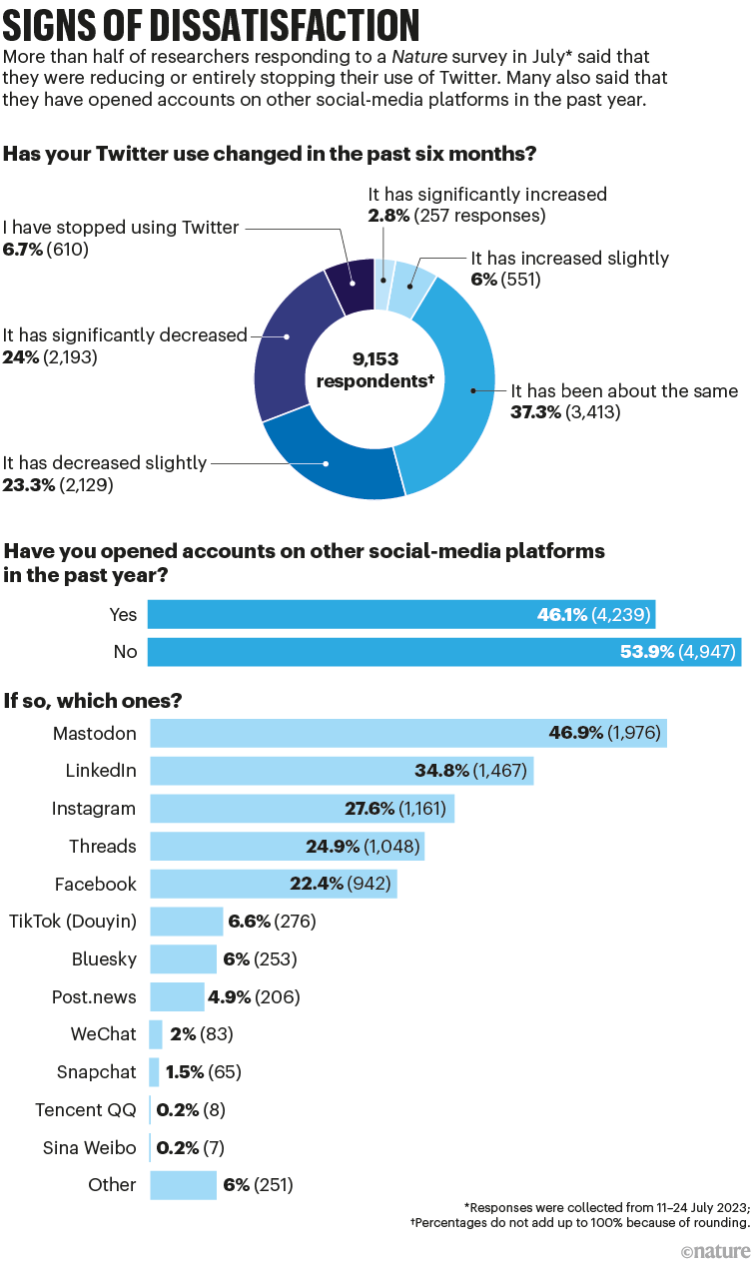
The proliferation of platforms has created a fragmented landscape for science communication and community, says Inger Mewburn, an education and technology researcher at the Australian National University in Canberra. One of the advantages of Twitter was that it was the main platform where researchers could go to find specific information. “People would just go to that hashtag and they’d see everyone who was talking about a very particular interest,” she says. Now, researchers need to hop from application to application following specific communities and individuals. “It’s just hard to know where people are hanging out,” Mewburn says.
Some researchers are trying to stick around. Malek says that, for the time being, he will continue using X to promote his work; he published a paper on land degradation in Asia in July and he’s working on another one about livestock grazing in Europe that he also hopes to promote through X. But a lot of the people that he follows have left and he’s not sure how much longer he will continue.
What is being lost?
There is still no consensus on whether X will survive its current chaotic management. In July, Musk announced the company is running on a “negative cash flow” because it has lost 50% of its advertisement revenue. And a lawsuit against the company is claiming it owes US$500 million in severance benefits to former employees.Many scientists lament what is being lost in the process.
{continued}
One of the benefits of Twitter was how it created a sense of community for scientists, particularly for those from under-represented groups. It gave a voice to female researchers about issues such as harassment and unequal pay, and served as an organizing point for scientists of colour to speak out against inequity. Scientists could discuss suspicions of research fraud, often anonymously, and because many journalists used the platform, people who might otherwise have been ignored sometimes got results. Dorador says that Twitter helped to raise awareness and accountability for concepts such as scientific colonialism and gender and sexual diversity.
The dynamics of networks on Twitter were also of great interest to researchers. Unlike many other social networks, Twitter had, until recently, an open application programming interface (API) that allowed scientists to explore how people interacted with the platform and with one another, leading to studies on how users were discussing climate change, how people with autism were using it to be heard and the patterns of account suspensions relating to Russia’s invasion of Ukraine, among other things.
In February, the platform announced that it would close the free access to its API, although the change didn’t come into effect until the end of June. Since then, research on misinformation, disaster responses and social dynamics on the Internet has been halted or hampered. Costas and Dudek, for example, don’t have free access to new data to further their research on how users engage with science and create communities. They now have to rely on information from previous analyses. “There’s still so many things that I would like to do,” Dudek says.
He and Costas also worry that these changes will halt their collaborations with other scientists in the field. “The way academics could access Twitter also created a nice framework for sharing data,” Costas says. Now, someone who pays to access X data will not be able to share it with others to do complementary research or replicate findings unless the other team also pays, he says.
Jarochowska suggests that scientists focus on organizing webinars, building networks to share data and methods, and finding original ways to stand out. In some ways, she’s glad to have put Twitter behind her. “If you appear with your scientific contents between videos of cats,” she says, “it’s not a particularly good medium for promoting yourself professionally, anyway”.
Mark Carrigan, a digital sociologist at the Manchester Institute for Education, UK, argues that the idea that Twitter helped democratize academia “was a bit simplistic” because social media created a space where academic celebrities thrived. Even when it helped to diversify science, he says, it did so through the reinforcement of the same kinds of hierarchy. “Rewards flow to those who are known, valued and heard while those who are unknown, unvalued and unheard struggle to increase their standing,” he wrote in a 2019 article.
He now emphasizes that conventional networking organizations should be eyeing this as an opportunity. Professional associations, societies, study groups, research networks, research centres and laboratories have a responsibility to curate and support their own networks, he says. “I’m 99% convinced that Twitter, as we know it, is dead, and the sooner academics accept that, the better, in terms of finding solutions to these problems.”
One of the benefits of Twitter was how it created a sense of community for scientists, particularly for those from under-represented groups. It gave a voice to female researchers about issues such as harassment and unequal pay, and served as an organizing point for scientists of colour to speak out against inequity. Scientists could discuss suspicions of research fraud, often anonymously, and because many journalists used the platform, people who might otherwise have been ignored sometimes got results. Dorador says that Twitter helped to raise awareness and accountability for concepts such as scientific colonialism and gender and sexual diversity.
The dynamics of networks on Twitter were also of great interest to researchers. Unlike many other social networks, Twitter had, until recently, an open application programming interface (API) that allowed scientists to explore how people interacted with the platform and with one another, leading to studies on how users were discussing climate change, how people with autism were using it to be heard and the patterns of account suspensions relating to Russia’s invasion of Ukraine, among other things.
In February, the platform announced that it would close the free access to its API, although the change didn’t come into effect until the end of June. Since then, research on misinformation, disaster responses and social dynamics on the Internet has been halted or hampered. Costas and Dudek, for example, don’t have free access to new data to further their research on how users engage with science and create communities. They now have to rely on information from previous analyses. “There’s still so many things that I would like to do,” Dudek says.
He and Costas also worry that these changes will halt their collaborations with other scientists in the field. “The way academics could access Twitter also created a nice framework for sharing data,” Costas says. Now, someone who pays to access X data will not be able to share it with others to do complementary research or replicate findings unless the other team also pays, he says.
What happens next?
Whether X will manage to regain its attractiveness to scientists, or whether some other social-media platform will grow into its space, is unclear. Mewburn doesn’t see the loss of Twitter as a fatal blow to the scientific enterprise. “I don’t think science has become overly dependent on social media,” she says. Scientists might find it more difficult to network and build their careers, especially if they don’t have the money to go to conferences, but she expects that people will come up with creative new ideas.Jarochowska suggests that scientists focus on organizing webinars, building networks to share data and methods, and finding original ways to stand out. In some ways, she’s glad to have put Twitter behind her. “If you appear with your scientific contents between videos of cats,” she says, “it’s not a particularly good medium for promoting yourself professionally, anyway”.
Mark Carrigan, a digital sociologist at the Manchester Institute for Education, UK, argues that the idea that Twitter helped democratize academia “was a bit simplistic” because social media created a space where academic celebrities thrived. Even when it helped to diversify science, he says, it did so through the reinforcement of the same kinds of hierarchy. “Rewards flow to those who are known, valued and heard while those who are unknown, unvalued and unheard struggle to increase their standing,” he wrote in a 2019 article.
He now emphasizes that conventional networking organizations should be eyeing this as an opportunity. Professional associations, societies, study groups, research networks, research centres and laboratories have a responsibility to curate and support their own networks, he says. “I’m 99% convinced that Twitter, as we know it, is dead, and the sooner academics accept that, the better, in terms of finding solutions to these problems.”
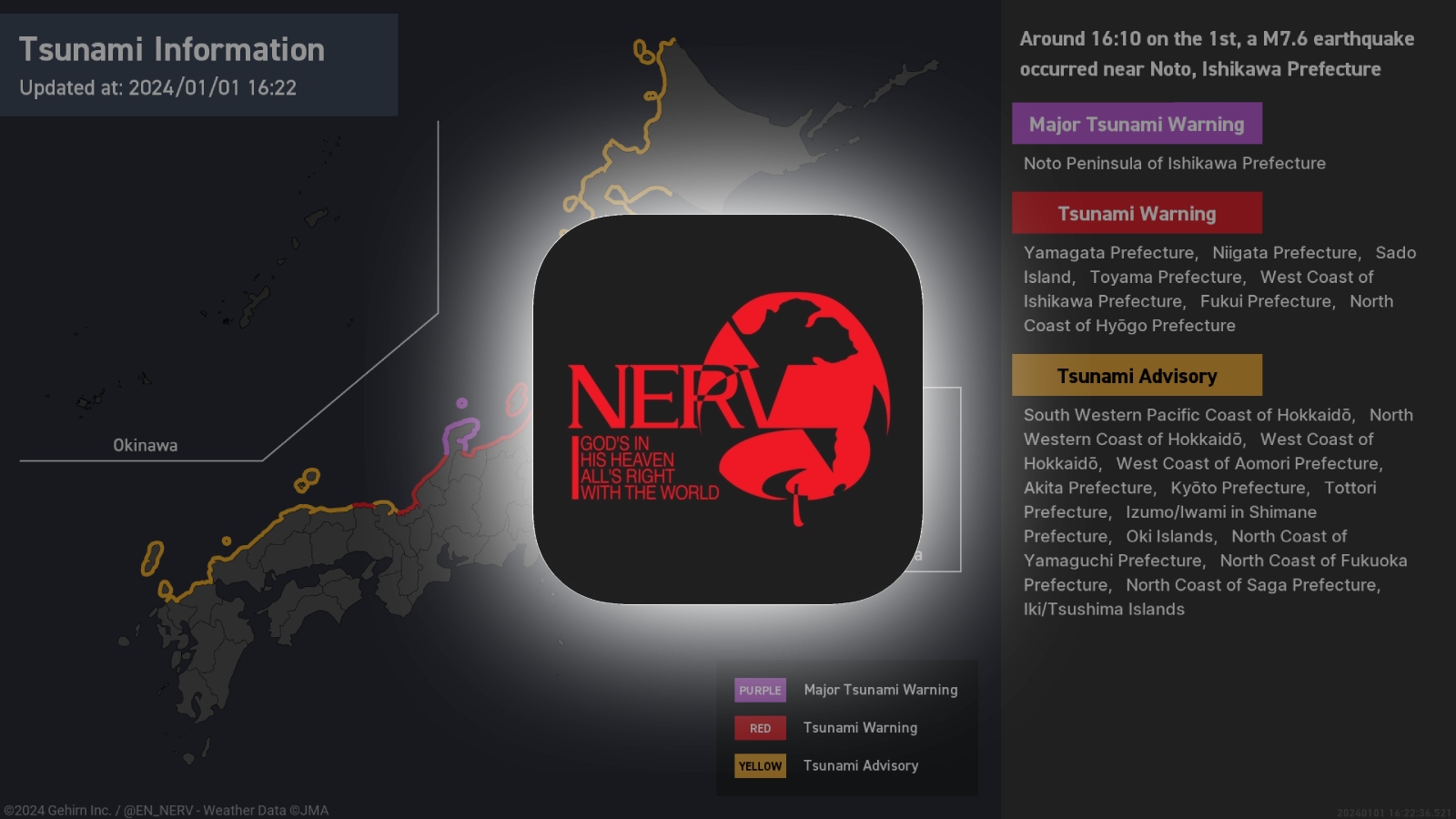
Japanese disaster prevention X account can’t post anymore after hitting API limit - Dexerto
Japanese disaster prevention app NERV can't post to the platform after hitting X's API rate limitations.
Japanese disaster prevention X account can’t post anymore after hitting API limit
Sayem Ahmed❘ Published: Jan 01, 2024, 05:39 ❘ Updated: Jan 01, 2024, 05:39

Japanese disaster prevention app NERV can’t post after reaching X’s API limitation. The issue has arisen after major Tsunami warnings have been issued in areas of Japan following a strong earthquake.
Japan has ordered evacuations across several prefectures following a strong earthquake, which reached a magnitude of 7.6 in the Noto area of the Ishikawa prefecture. Following this, warnings of waves as high as 5m have been issued, with residents ordered to evacuate immediately.
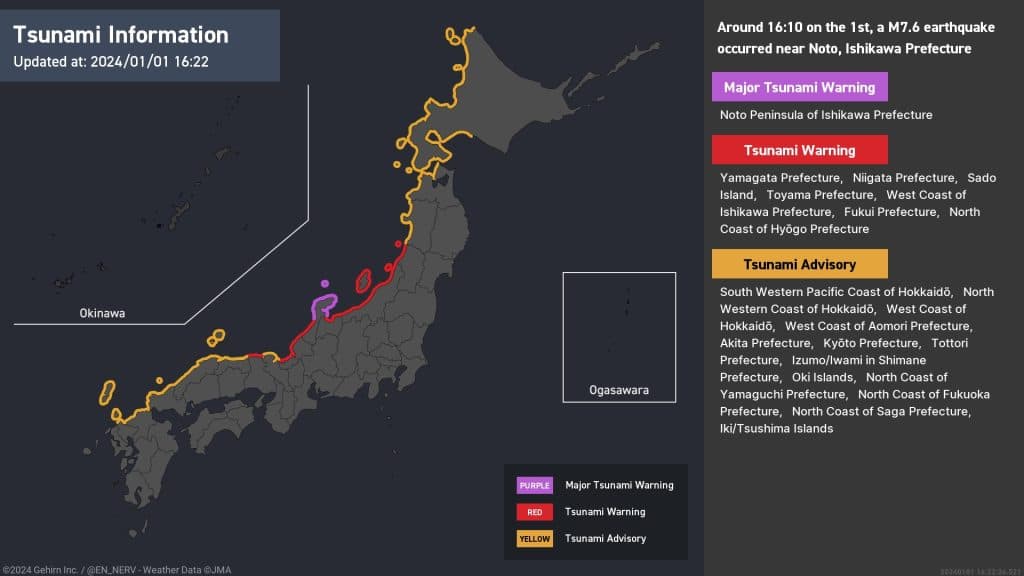
Neighboring prefectures have also received warnings, with much of Japan’s West coast under an advisory evacuation advisory. Disaster prevention account “NERV” offers warnings of earthquakes and disaster reporting, with the account keeping Japanese residents informed in both English and Japanese languages on X.
Now, the app is facing significant API rate limitations due to new policies put forward under Elon Musk’s ownership of the platform. It can no longer post updates to its combined following of over two million users.
According to Unseen Japan, NERV is under X’s “Basic” API plan, where it can post 100 posts in 24 hours. This costs around $100, while the next step up requires users to pay around $5000 a month for usage of its API. Due to NERV running at a loss, the company has chosen not to subscribe to the higher tier.
An app-based alternative
Luckily, the creators of the NERV App, Gehirn Inc, have created an app-based alternative for users to get information in real-time, as well as running a Mastodon account. But, that has not stopped some users asking Elon Musk to lift API restrictions for the NERV app. These calls have even reached the ears of Japanese X employee Ryuji M, Director of Next at X in Japan and Korea.NERV offers highly accurate information for disaster prevention and X offers a quick way to see updated information in a centralized location during these events. But, since X’s new API limitations have hit the platform, it appears that for now, users might have to look elsewhere for the potentially life-saving information.
Dexerto's Hardware Editor. Sayem is an expert in all things Nvidia, AMD, Intel, and PC components. He has 10 years of experience, having written for the likes of Eurogamer, IGN, Trusted Reviews, Kotaku, and[/SIZE]